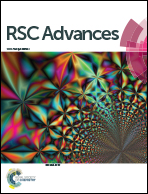Insights into the specific heat capacity enhancement of ternary carbonate nanofluids with SiO2 nanoparticles: the effect of change in the composition ratio
Abstract
Ternary carbonate nanofluids have proven to be a promising high temperature thermal energy storage and transfer medium for solar thermal power. For the ternary carbonate K2CO3–Li2CO3–Na2CO3 (4 : 4 : 2, mass ratio) with SiO2 nanoparticles prepared using a two-step solution method, the enhancement of the specific heat capacity was up to 113.7% at 540 °C compared to the ternary carbonate prepared by a direct mixing method. The present work aims to give insights into the marked enhancement of specific heat capacity. The effect of evaporation temperature on the nanostructures formed in ternary carbonate nanofluids is discussed for the enhancement of specific heat capacity. More importantly, based on an analysis of inductively coupled plasma atomic emission spectrometry, it is revealed that the composition ratio of the ternary carbonate, which can influence its specific heat capacity, was changed during the evaporation process in an electrothermal drier. Besides a difference in the solubility of the carbonates in water, it is demonstrated that the heating mode can affect the composition ratio of mixed molten salts.



 Please wait while we load your content...
Please wait while we load your content...